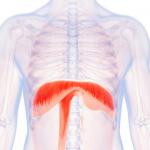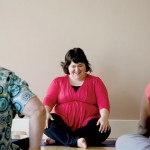
Breath is the essence of life. Are you breathing well?
by Kara-Leah,
I know, you’re breathing already, automatically, all the time – about 25,000 breaths day.
But are you really breathing?
Stop right now.
Place both hands lightly on your belly. Exhale ALL the air out your lungs through your nose.
Now inhale (through the nose) slow and strong right down into your belly, pushing your hands softly outward.
Exhale again, all of that air. Inhale thoroughly. Keep moving your hands with your breath, up and down, up and down.
NOW you’re breathing – this is abdominal breathing. It’s the first way beginning yoga students are taught to breathe. As you read through this article, keep breathing down into your belly.
There are three main compartments to the lungs, and most of us spend all day shallow breathing just into the upper lobes of the lungs. That means that only a small amount of air is taken in – and the oxygen contained in that air has to nourish every single cell in your body.
But the best way to breathe is diaphragmatic breathing. A description of this is beyond the scope of this article, but this site has fantastic information. You know you’re using a supported diaphragm to breathe when your lower ribs expand outward and your are breathing into your spine.
Breathe properly and you send oxygen flooding into every single cell in your body. Yep – your cells BREATHE. The air doesn’t just come into your lungs, it’s taken to every single cell in your body via your circulation system. Every cell in your body inhales the oxygen and exhales the carbon dioxide – a process called respiration.
Breathing is important because our cells constantly need a new supply of oxygen so they can produce energy – without this vital oxygen, cellular function is impaired, and damage or cell death is possible.
After all, you can live for weeks without food, days without water and how long without air? Maybe 6 minutes?
Air is the very essence of life.
And that is why in Vedic and yogic tradition, air is linked to Prana – the life force that flows through all living creatures – plant and animal. Working with the breath is called pranayama.
Yoga.net defines Prana like this:
In prana, the root word ‘pra,’ meaning ‘to fill,’ is added to the root word, ‘an,’ (‘to breathe’ or ‘to live’) creating the new meaning ‘the life that fills with the breath.’ In other words the life principle in action.
Prana commonly translates as ‘air,’ ‘breath,’ ‘spirit,’ ‘life,’ ‘life force,’ ‘energy,’ ‘subtle energy,’ or ‘the upwards moving energy currents within the body.’
Prana is a subtle form of energy. Prana literally means ‘breathing forth’ the universal life force.
In my role as a yoga teacher, and as a Toastmaster, I notice how people breathe. A Toastmaster who is nervous and fearful may get up and take short, sharp breaths, or they may hold their breathe very tight. Or perhaps they barely breathe at all. Often, as a speech evaluator, I tell people to practice breathing properly when they speak. It slows speakers down, grounds them, and also calms the nervous system.
Because breathing is an automatic function, it’s controlled by the autonomic nervous system – makes sense huh?
This nervous system has two parts: the sympathetic and the parasympathetic nervous systems. The sympathetic is the fight or flight system – it prepares the body for sudden stress by controlling physical things like our heart rate, the adrenal glands and our breathing. The parasympathetic system does the opposite – it prepares the body for rest, and also helps the digestive system work more efficiently to extract nutrients from our food.
When you are in a fearful situation, you can consciously shift the body into the parasympathetic system using your breath. This part of conscious living – paying attention to the physicality of your body, the heart rate, the sweat glands, the breath, and the adrenal glands, and shifting it via breathing. It’s such a simple technique, and it’s so powerful.
When you spend your entire day breathing shallow, short, sharp breaths, you are likely keeping your body in the sympathetic system, and this signals STRESS to the body. It’s no wonder so many people feel stressed out – their breathing makes their body react as if they are. So they are.
Proper breathing is the heart of both yoga and meditation – without breath, you don’t have a yoga posture. When I teach, I listen to the way my students breathe in the postures and I can tell how they are experiencing the posture – whether they need to back out, go deeper (and this refers to deepening the BREATH, not the stretch) or whether their mind is wandering.
Thousands of years ago, in the yogic text the Upanishads, yogis described their experiential understanding of the body via five layers, or sheaths. They called these layers kosha.
Shiva Rea explains it clearly in Yoga Journal:
According to the map of the koshas, we are composed of five layers, sheaths, or bodies. Like Russian dolls, each metaphorical ‘body’ is contained within the next:
- annamaya kosha—the physical body;
- pranamaya kosha—the breath or life-force body;
- manomaya kosha—the mental body;
- vijanamaya kosha—the wisdom body;
- anandamaya kosha—the bliss body.
From the kosha perspective, yoga helps us bring body, breath, mind, wisdom, and spirit (bliss) into harmony. Like a tapestry, the koshas are interwoven layers.
You would perish if your pranamaya kosha, or breath body, ceased to function. Throughout the day the breath body can go unnoticed and become limited in range, like a caged bird that forgets how to fly.
To experience the pranamaya kosha, contemplate the reality of how your next inhalation literally circulates through your entire body through the oxygen in your bloodstream. On a physiological level, the layer of prana refers to your circulatory and respiratory systems—the rivers of life flowing in you—as well as to the flow of feelings in your body.
As you increase the amount of oxygen in your body, this pranic body starts to come alive. The coordination of your inhalation and exhalation with the movements of your physical body, as in the Sun Salutations, is one of the ways in which the physical body and breath body become synchronized with the mental body (concentration and awareness).
Breathing is the most vital action we take in our lives, because it IS the essence of life for us. Yet it is also the most unconscious action that we take. For this reason, becoming conscious of how you breathe, and then deliberately directing the flow of breath and prana into your body is the single most powerful action you can take toward living a conscious life.
The reason people feel so amazing after a yoga class is not about the postures and the stretching and the moving. It’s because they just spent 90 minutes paying attention to their breathing. It’s because they have flooded every cell in their body with an abundance of oxygen and those cells are firing with energy. It’s because they have consciously connected to prana – the life force that permeates the universe.
Whatever it is that ails you – whether it’s an agitated mind, a dullness of body, an addiction to food or an inability to express emotions – simply starting to breathe properly can have a profound effect on your experience of life.
For miraculous stories about the power of pranayama (breath work), get your hands on a copy of Bri. Maya Tiwari’s book The Path of Practice. She described several instances where prescribed pranayama dramatically shifted people’s experience of anxiety, insomnia and depression.
Take a deep breath in now, and ride that wave into your body.
Follow it, feel it, experience it.
Your breath is the bridge between mind, body and soul.
Connect with your breath, and you can connect with who you truly are.
This article has been featured in Fit Buff’s Total Mind and Body Fitness Carnival.


This is, was, and will remain, one of my favorites of yours.
I’m glad that you posted it here. 🙂
Blessings,
Vera Nadine
Hey Vera,
It’s nice to be able to bring back some of the old articles – especially when they even reference Shiva Rea!
Blessings,
KL
V.use full n suprb knowledge about breathing yoga n many more thank you so much ??